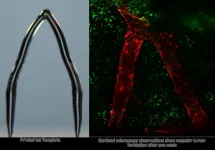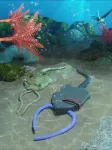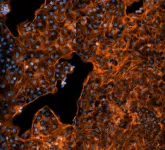(Press-News.org) People who have had cancer often experience ongoing pain, but a new study reveals that being physically active may help lessen its intensity. The study is published by Wiley online in CANCER, a peer-reviewed journal of the American Cancer Society.
Although physical activity has been shown to lessen various types of pain, its effects on cancer-related pain are unclear. To investigate, a team led by senior author Erika Rees-Punia, PhD, MPH, of the American Cancer Society, and first author Christopher T.V. Swain, PhD, of the University of Melbourne, in Australia, analyzed information pertaining to 51,439 adults without a history of cancer and 10,651 adults with a past cancer diagnosis. Participants were asked, “How would you rate your pain on average,” with responses ranging from 0 (no pain) to 10 (worst pain imaginable). Participants were also asked about their usual physical activity.
U.S. guidelines recommend 150 minutes (2 hours 30 minutes) to 300 minutes (5 hours) a week of moderate-intensity, or 75 minutes (1 hour 15 minutes) to 150 minutes (2 hours 30 minutes) a week of vigorous-intensity aerobic physical activity.
Based on participants’ responses, the investigators found that, for individuals who had cancer in the past as well as for those without a history of cancer, more physical activity was linked with lower pain intensity. The extent of the association was similar for both groups of individuals, indicating that exercise may reduce cancer-related pain just as it does for other types of pain that have been studied in the past.
Among participants with a past cancer diagnosis, those exceeding physical activity guidelines were 16% less likely to report moderate-to-severe pain compared to those who failed to meet physical activity guidelines. Also, compared with people who remained inactive, those who were consistently active or became active in older adulthood reported less pain.
“It may feel counterintuitive to some, but physical activity is an effective, non-pharmacologic option for reducing many types of pain. As our study suggests, this may include pain associated with cancer and its treatments,” said Dr. Rees-Punia.
Additional information
NOTE: The information contained in this release is protected by copyright. Please include journal attribution in all coverage. A free abstract of this article will be available via the CANCER Newsroom upon online publication. For more information or to obtain a PDF of any study, please contact: Sara Henning-Stout, newsroom@wiley.com
Full Citation:
“Physical activity and pain in people with and without cancer.” Christopher T.V. Swain, Matthew Masters, Brigid M. Lynch, Alpa V. Patel, and Erika Rees-Punia. CANCER; Published Online: February 12, 2024 (DOI: 10.1002/cncr.35208).
URL Upon Publication: http://doi.wiley.com/10.1002/cncr.35208
Author Contact: Danielle Galvin, Media and Communications Adviser, University of Melbourne at danielle.galvin@unimelb.edu.au; and Anne Reynolds-Doerr, Director of Medical & Scientific Communications at the American Cancer Society, at anne.doerr@cancer.org
About the Journal
CANCER is a peer-reviewed publication of the American Cancer Society integrating scientific information from worldwide sources for all oncologic specialties. The objective of CANCER is to provide an interdisciplinary forum for the exchange of information among oncologic disciplines concerned with the etiology, course, and treatment of human cancer. CANCER is published on behalf of the American Cancer Society by Wiley and can be accessed online. Follow CANCER on Twitter @JournalCancer and Instagram @ACSJournalCancer, and stay up to date with the American Cancer Society Journals on LinkedIn.
About Wiley
Wiley is a knowledge company and a global leader in research, publishing, and knowledge solutions. Dedicated to the creation and application of knowledge, Wiley serves the world’s researchers, learners, innovators, and leaders, helping them achieve their goals and solve the world's most important challenges. For more than two centuries, Wiley has been delivering on its timeless mission to unlock human potential. Visit us at Wiley.com. Follow us on Facebook, Twitter, LinkedIn and Instagram.
END
Does physical activity lessen pain intensity for cancer survivors?
Study shows that higher levels of physical activity are linked with less pain, and to a similar extent in adults with and without a history of cancer
2024-02-12
ELSE PRESS RELEASES FROM THIS DATE:
Prolonged cough? In most cases, patience is the treatment
2024-02-12
Coughing after a respiratory infection is common and, in most cases, will resolve with time, according to an article in CMAJ (Canadian Medical Association Journal) https://www.cmaj.ca/lookup/doi/10.1503/cmaj.231523.
With the recent bout of respiratory infections across Canada, many people are suffering from a postinfectious cough, or a cough that lasts for weeks after the initial infection has resolved.
"Reassuring patients that postinfectious cough is time limited and self resolving is important and can reduce unnecessary and costly prescriptions, such as asthma puffers or antibiotics," ...
Study finds adolescents with concussion may benefit from more activity earlier
2024-02-12
(COLUMBUS, Ohio) – Researchers at Nationwide Children’s Hospital have found that when it comes to concussion recovery, activity type matters. In a study published today in British Journal of Sports Medicine, researchers found that limiting screen time and returning to school early following a concussion may speed up recovery.
“Increased time spent in the classroom, participating in some after-school activities or working a job was associated in our study with faster symptom resolution, especially ...
There is no proof that AI can be controlled, according to extensive survey
2024-02-12
There is no current evidence that AI can be controlled safely, according to an extensive review, and without proof that AI can be controlled, it should not be developed, a researcher warns.
Despite the recognition that the problem of AI control may be one of the most important problems facing humanity, it remains poorly understood, poorly defined, and poorly researched, Dr Roman V. Yampolskiy explains.
In his upcoming book, AI: Unexplainable, Unpredictable, Uncontrollable, AI Safety expert Dr Yampolskiy looks at the ways that AI has the potential to dramatically reshape society, not always to our advantage.
He explains: “We are facing an almost guaranteed event with ...
The Complete Library of Charles Darwin revealed for the first time
2024-02-11
Charles Darwin – arguably the most influential man of science in history, accumulated a vast personal library throughout his working life. Until now, 85 per cent of its contents were unknown or unpublished.
This year, coinciding with Darwin’s 215th birthday, The Complete Work of Charles Darwin Online, the scholarly project helmed by Dr John van Wyhe at the National University of Singapore (NUS) Department of Biological Sciences, has released an online 300-page catalogue detailing Darwin’s complete personal library, with 7,400 titles across 13,000 volumes and items including books, pamphlets and journals. ...
Anne Ephrussi wins the FEBS | EMBO Women in Science Award 2024
2024-02-11
11 February 2024 – EMBO and FEBS are delighted to announce that Anne Ephrussi, emerita of EMBL Heidelberg, Germany, is the recipient of this year's FEBS | EMBO Women in Science Award. It celebrates outstanding female life scientists, recognizing their research achievements and contribution to a particular discipline over the past five years in Europe. The awardees are inspiring role models who help pave the way for future generations of women in science.
“It is a huge honour and most humbling to receive the FEBS | EMBO Women in Science Award. This recognition ...
3D ice printing can create artificial blood vessels in engineered tissue
2024-02-10
ROCKVILLE, MD – Over 100,000 individuals in the United States are currently in need of organ transplants. The demand for organs, such as hearts, kidneys, and livers, far exceeds the available supply and people sometimes wait years to receive a donated organ. Approximately 6,000 Americans die while waiting each year.
Tissue engineering to create lab-grown organs and tissues aims to close the gap between the availability of organs and the demand for transplants. But one big challenge in tissue engineering is creating blood vessel networks in artificial organs that work like natural ...
How ancient sea creatures can inform soft robotics
2024-02-10
ROCKVILLE, MD – Soft robotics is the study of creating robots from soft materials, which has the advantage of flexibility and safety in human interactions. These robots are well-suited for applications ranging from medical devices to enhancing efficiency in various tasks. Additionally, using different forms of robotic movement may also serve us well in exploring the ocean or space, or doing certain jobs in those environments.
To broaden our understanding of locomotion, Richard Desatnik, who works in the labs of Philip LeDuc ...
Why ventilators can be tough on preemie lungs
2024-02-10
ROCKVILLE, MD – Many premature infants need mechanical ventilation to breathe. However, prolonged ventilation can lead to problems like respiratory diseases or ventilation-induced injury.
Jonas Naumann and Mareike Zink study the physics of mechanical stress from ventilation at Leipzig University, in Leipzig, Germany and discovered some of the mechanisms that explain why premature lungs are especially sensitive to stress. Naumann will present their research at the 68th Biophysical Society Annual Meeting, to be held February 10 - 14, 2024 in Philadelphia, Pennsylvania.
When you breathe normally, your diaphragm and the muscles between ribs create a negative pressure inside the ...
Using ion beams to improve brain microscopy
2024-02-10
ROCKVILLE, MD – Improving the way scientists can see the microscopic structures of the brain can improve our understanding of a host of brain diseases, like Alzheimer’s or multiple sclerosis. Studying these diseases is challenging and has been limited by accuracy of available models.
To see the smallest parts of cells, scientists often use a technique called electron microscopy. Electron microscopy historically involves adding chemicals and physically cutting the tissue. However, this approach can change the way the cells and structures look, perturbing their natural state, and can limit resolution. ...
Faster monkeypox (mpox) testing through CRISPR
2024-02-10
ROCKVILLE, MD – Mpox, formerly known as monkeypox, is a rare viral disease that is spread through physical contact between people. Currently, testing for mpox requires lab equipment and can take a few hours to get test results. But new research suggests a way for faster testing that could be done in any clinic soon.
Md. Ahasan Ahamed, a graduate student mentored by Weihua Guan at Pennsylvania State University will present this research at the 68th Biophysical Society Annual Meeting, to be held February 10 - 14, 2024 in Philadelphia, Pennsylvania.
Though mpox symptoms are generally mild with fever, rash, and swollen lymph nodes, severe cases can occur and require medical attention. ...
LAST 30 PRESS RELEASES:
Duke and Duke-NUS’ joint cross-population research to uncover "East-West" differences in disease and care
Scientists to ‘spy’ on cancer- immune cell interactions using quantum technology breakthrough
Tech savvy users have most digital concerns
Making lighter work of calculating fluid and heat flow
Normalizing blood sugar can halve heart attack risk
Lowering blood sugar cuts heart attack risk in people with prediabetes
Study links genetic variants to risk of blinding eye disease in premature infants
Non-opioid ‘pain sponge’ therapy halts cartilage degeneration and relieves chronic pain
AI can pick up cultural values by mimicking how kids learn
China’s ecological redlines offer fast track to 30 x 30 global conservation goal
Invisible indoor threats: emerging household contaminants and their growing risks to human health
Adding antibody treatment to chemo boosts outcomes for children with rare cancer
Germline pathogenic variants among women without a history of breast cancer
Tanning beds triple melanoma risk, potentially causing broad DNA damage
Unique bond identified as key to viral infection speed
Indoor tanning makes youthful skin much older on a genetic level
Mouse model sheds new light on the causes and potential solutions to human GI problems linked to muscular dystrophy
The Journal of Nuclear Medicine ahead-of-print tip sheet: December 12, 2025
Smarter tools for peering into the microscopic world
Applications open for funding to conduct research in the Kinsey Institute archives
Global measure underestimates the severity of food insecurity
Child survivors of critical illness are missing out on timely follow up care
Risk-based vs annual breast cancer screening / the WISDOM randomized clinical trial
University of Toronto launches Electric Vehicle Innovation Ontario to accelerate advanced EV technologies and build Canada’s innovation advantage
Early relapse predicts poor outcomes in aggressive blood cancer
American College of Lifestyle Medicine applauds two CMS models aligned with lifestyle medicine practice and reimbursement
Clinical trial finds cannabis use not a barrier to quitting nicotine vaping
Supplemental nutrition assistance program policies and food insecurity
Switching immune cells to “night mode” could limit damage after a heart attack, study suggests
URI-based Global RIghts Project report spotlights continued troubling trends in worldwide inhumane treatment
[Press-News.org] Does physical activity lessen pain intensity for cancer survivors?Study shows that higher levels of physical activity are linked with less pain, and to a similar extent in adults with and without a history of cancer






